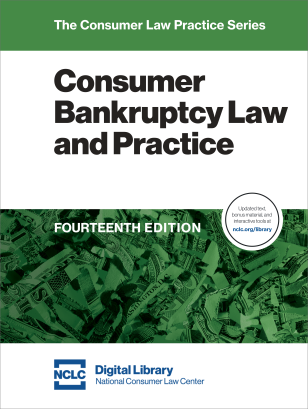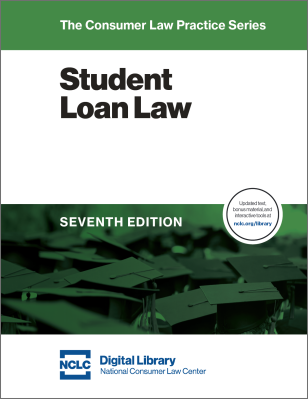On August 9, 2024, the Eighth Circuit Court of Appeals entered an injunction pending appeal preventing the Secretary of Education from implementing the SAVE plan and related regulations that were to take effect on July 1, 2024. While the focus of the litigation is on the SAVE plan, the injunction more broadly enjoins implementation of the Department of Education’s final rule, Improving Income Driven Repayment for the William D. Ford Federal Direct Loan Program and the Federal Family Education Loan (FFEL) Program, 88 Fed. Reg. 43820 (July 10, 2023), which includes the provision for IDR forgiveness credit in chapter 13 bankruptcy cases discussed in this article. Until the appeal is concluded, practitioners should consider advising debtors to propose a plan permitting continued participation in IDR as discussed in the Fourth Practice Tip below. Examples of chapter 13 plan provisions that require enrollment or continued participation in IDR plans can be found in NCLC’s Consumer Bankruptcy Law and Practice Appendix G.3, Form 18.
Effective July 1, 2024, a new Department of Education regulation substantially changes how income-driven repayment (IDR) plans are treated when a student loan borrower is a debtor in a chapter 13 bankruptcy case. The regulation gives the debtor a month of credit toward loan forgiveness for each month the debtor makes a required plan payment under a confirmed chapter 13 plan.
This article explains the new regulation’s four key changes and gives four essential practice tips for dealing with student loans in chapter 13 cases.
This rule change is separate from the December 2022 Department of Justice Guidance that provides a new avenue for student loan borrowers to obtain a hardship discharge in chapter 7 and chapter 13 bankruptcy cases. For information on that guidance, see New Process to Discharge Student Loans in Bankruptcy (updated March 7, 2023).
First New Rule Change: IDR Payment Not Required
The new regulation, 34 C.F.R. § 685.209(k)(4)(iv)(K), states that “[f]or all IDR plans, a borrower receives a month of credit toward forgiveness by ... [d]eferring or forbearing monthly payments under ... a bankruptcy forbearance ... on or after July 1, 2024, if the borrower made the required payments on a confirmed bankruptcy plan.”
The text makes clear that IDR forgiveness credit is determined by the debtor’s bankruptcy plan payments, not IDR payments. A debtor is thus given IDR credit for each month that a debtor makes a chapter 13 plan payment, even if no IDR payments are made, and even if the Department of Education (Department) does not file a proof of claim or does not receive any distributions under the debtor’s plan.
While the text refers to the debtor making “the required payments on a confirmed bankruptcy plan,” completion of all plan payments is not required. The Department acknowledged in the section-by-section analysis when issuing the regulation that “not all borrowers successfully complete the plan” and that “the Department will award credit toward IDR forgiveness for months where the Secretary determines that the borrower made payments under an approved bankruptcy plan.” 88 Fed. Reg. 43,854 (July 10, 2023). For example, if the debtor makes 24 plan payments under a 60-month confirmed plan, but the chapter 13 case is dismissed without discharge in month 30, the regulation gives the debtor 24 months of IDR forgiveness credit.
Second New Rule Change: Plan Provision Not Required (But Recommended)
The regulation responds to a significant problem chapter 13 debtors have faced. When a student loan borrower files for bankruptcy, the Department places all of the debtor’s federal loans in an administrative bankruptcy forbearance. This has meant that most chapter 13 debtors have not received credit for IDR loan forgiveness while their cases are pending for 3 to 5 years. Some debtors have tried to overcome this obstacle with chapter 13 plan provisions that require enrollment or continued participation in IDR plans. See NCLC’s Consumer Bankruptcy Law and Practice Appendix G.3, Form 18 pts. D and E. In issuing the regulation, the Department stated that this plan “option is infrequently used and confusing for borrowers.” 88 Fed. Reg. 43,854 (July 10, 2023).
The policy goal of the new regulation is to ensure that a debtor is not penalized for being in an administrative forbearance when in a chapter 13 case. The need for a specific plan provision is therefore no longer necessary. The debtor’s plan may provide simply for the student loans to be treated under the plan provision for payment of nonpriority unsecured debts.
However, there are circumstances when a plan provision providing for continued, postpetition participation in an IDR plan will be the better option. Moreover, all debtors with student loans should include a plan provision that seeks to implement the new regulation. The use of these plan provisions is discussed below.
Third New Rule Change: IDR Enrollment Not Required
As mentioned, to qualify for IDR forgiveness credit and to avoid other problems with being in an administrative bankruptcy forbearance, such as negative amortization and capitalization of interest, some debtors have sought court approval through the plan confirmation process to enroll and participate (including annual recertifications) in IDR plans. Under the new regulation, a debtor will get IDR credit even if they are not enrolled in an IDR plan before or during the chapter 13 case.
It is advisable, however, for the debtor to enroll in an IDR plan before filing the chapter 13 case, or immediately after the case is closed, as discussed below.
Fourth New Rule Change: Separate Classification Not Required
A debtor’s chapter 13 plan generally must pay all nonpriority unsecured creditors the same amount, though a debtor may under 11 U.S.C. § 1322(b)(1) separately classify some unsecured debt, such as the debtor’s student loans, if that treatment does not discriminate unfairly against other classes of unsecured creditors. Another difficulty debtors have faced in trying to stay on an IDR plan when in chapter 13 is proving that separate payment of their student loans will not unfairly discriminate.
For example, the debtor’s plan may propose to continue making the debtor’s prepetition IDR payment of $250 per month, resulting in a total of $9,000 in separate IDR payments during a 36-month plan. If the plan also provides only a total of $2,500 to other nonpriority unsecured creditors and a large number of these creditors have filed significant claims, the court may find that separate IDR payment is not fair discrimination and deny confirmation of the plan. Recent court decisions have been divided, both in the method of analysis and the result, as to whether debtors can separately classify student loan debt. See NCLC’s Consumer Bankruptcy Law and Practice § 12.4.3.
The new regulation avoids this problem as there is no need to separately classify federal student loans in order to qualify for IDR forgiveness credit. The debtor will get IDR credit even if the Department receives the same pro-rata distribution under the plan as other nonpriority unsecured creditors (or no distribution if it is a zero percent plan), so long as the debtor makes the required chapter 13 plan payments.
First Practice Tip: Check IDR Forgiveness Credit at Case Closing
The Department stated that it will not be automatically crediting months toward forgiveness for payments made during the chapter 13 plan. The Department noted that it will credit the months toward forgiveness “when we are notified that the borrower made the required payments on their approved bankruptcy plan.” 88 Fed. Reg. 43,854 (July 10, 2023).
While no specific mechanism for transmitting this information to the Department is discussed in the regulation or analysis, we believe that the Department will use the Chapter 13 Standing Trustee’s Uniform Final Report and Account form that is filed by the trustee within 150 days of the final distribution to creditors in the case. Item 6 on the Report lists: "Number of months from filing or conversion to last payment." In the example given above where the debtor made 24 plan payments under a 60-month plan before the case was dismissed in month 30, the trustee should list 24 in response to Item 6, and the Department should give the debtor 24 months of IDR forgiveness credit.
After the trustee has filed the final report, the debtor’s attorney should verify that the number of monthly plan payments is correctly reported and provide a copy of the report to the debtor’s student loan servicer. If the debtor’s attorney is unable to verify that the servicer has given or will give proper IDR forgiveness credit, the debtor’s attorney may wish to file a motion before the case is closed to obtain an order from the bankruptcy court confirming the number of plan payments made by the debtor. If the debtor’s confirmed plan includes a provision requiring compliance with the new regulation, a motion may be filed, including in a reopened case, seeking an order compelling the servicer and Department to give IDR credit for the months plan payments were made.
Debtors should be advised that they will need to begin making IDR payments when the bankruptcy case is closed and that they should provide any documentation requested by their servicer to recertify their income and family size for their IDR plan.
Second Practice Tip: Include Plan Provision Requiring Compliance with Regulation
Student loan servicers have often failed to properly implement the Department’s borrower assistance programs, particularly when a program is new or being changed. To protect debtors from being denied forgiveness credit under the new regulation, and a potential remedy in the bankruptcy court for failure to comply with the plan confirmation order, the debtor should include language in the plan compelling the Department and its servicers to comply with the regulation. For example, the debtor may include the following nonstandard provision:
Before filing this chapter 13 case, the debtor was providing for payment of their federal student loans by participating in an income-driven repayment plan provided by the U.S. Department of Education, under the [name of IDR program]. Upon filing the petition, the debtor was placed in an administrative bankruptcy forbearance, and is providing for the student loans under Part [section of plan providing for treatment of nonpriority unsecured claims]. Upon the closing of this case and in accordance with 34 C.F.R. § 685.209(k)(4)(iv)(K), the U.S. Department of Education and/or [name of student loan servicer, guarantor, or holder] shall give the debtor a month of credit toward loan forgiveness for each month that the debtor made a payment under the plan to the trustee, and shall permit the debtor to resume participation in the [name of IDR program].
Third Practice Tip: Advise Debtor to Get on IDR Plan Before Filing Case or Immediately After Case is Closed
The regulation and the Department’s analysis suggest that the debtor does not have to be enrolled in an IDR plan before the chapter 13 case is filed and may receive plan payment forgiveness credit at any time they begin participating in an IDR plan after the case is closed. Again, given the long history of problems with IDR program implementation and proper crediting of forgiveness credit, it is advisable for the debtor to verify receipt of the credit soon after the bankruptcy case is closed. There may be less chance of administrative errors if the debtor was on an IDR plan before filing chapter 13 and has resumed or begun participating in IDR as soon as the administrative forbearance has ended. If the trustee’s final report or other documentation is needed, this should be easier to obtain at the end of the bankruptcy case or soon after it closed.
Fourth Practice Tip: Include Plan Provision to Continue IDR Participation for Some Debtors
Despite the many advantages of the new regulation, some debtors may prefer to stay on an IDR plan while in chapter 13. For example, assume that a debtor has an IDR plan payment of $0 (or a small dollar amount) and files a chapter 13 case to cure a mortgage default. After making 15 monthly plan payments, the debtor loses a job. The debtor is initially granted a suspension of plan payments but eventually the case is dismissed after pending 22 months. Under the new regulation the debtor would receive 15 months of forgiveness credit. If the debtor’s confirmed plan provided for continued participation in IDR with the $0 payment, rather than administrative forbearance, the debtor would have received 22 months of credit while the case was pending.
Another Department regulation that is effective July 1, 2024, establishes shorter time frames for loan forgiveness for borrowers with smaller loan balances under a new IDR called the Saving on a Valuable Education (SAVE) plan. See NCLC’s Student Loan Law § 3.5.3.9.1. Borrowers whose total original principal balance on the loans being paid under a SAVE plan was less than $12,000 are eligible for forgiveness if they comply with plan requirements for 10 years. 34 C.F.R. § 685.209(k)(3). In the future, some chapter 13 debtors on a SAVE plan may be entitled to loan forgiveness under the shorter qualifying periods while the case is pending, for example during the first year of a 5-year plan. The administrative bankruptcy forbearance may require the debtor to wait an additional 4 years, when the case is closed, to receive loan forgiveness. In that situation it may be advisable for the debtor to propose a plan permitting continued participation in IDR rather than administrative forbearance.
Examples of chapter 13 plan provisions that require enrollment or continued participation in IDR plans can be found in NCLC’s Consumer Bankruptcy Law and Practice Appendix G.3, Form 18.



